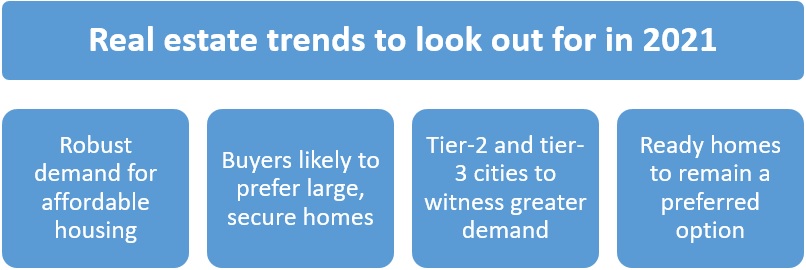The reality of Indian Real Estate may not have been what mathematical statistician Nassim Nicholas Taleb refers to as a “black swan-robust society.” Following the unprecedented challenges posed by the Coronavirus pandemic in early 2020, the Indian economy began to show signs of deterioration. The COVID-19 virus outbreak wreaked havoc on India’s economy in general, and its real estate sector in particular – an industry that is inherently dependent on human contact.
After the pandemic unfolded, all stakeholders in India’s real estate sector banded together to restore normality to the country.
2020: When Indian real estate changed for the better
While the year 2020 will be remembered for the Coronavirus and subsequent lockdowns, the year 2020 will be remembered for the economic turnaround and demand revival in India’s real estate sector, particularly in the Mumbai Metropolitan Region (MMR), according to Kaushal Agarwal, chairman of The Guardians Real Estate Advisory.
In the wake of the lockdown, many people predicted this would be the year of the greatest housing collapse. The result was quite the opposite, with November 2020 recording the highest number of residential registrations in nearly a decade (in Maharashtra),” Agarwal says, adding that such an unprecedented and unimaginable recovery was possible as a result of the Reserve Bank of India’s (RBI’s) decision to lower repo rates and state governments lowering stamp duty.
Mohit Goel, CEO of Omaxe, believes the COVID-19 crisis holds promise for Indian real estate sector and economy going forward.

In addition to its unprecedented global impact, 2020 will usher in an era of innovation and digitization for the real estate industry. As we continue to learn how to live in this COVID era, 2021 will require us to reimagine how we have previously operated,” According to Magazine, the real estate sector has not been spared from the rebalancing, but has demonstrated remarkable resilience in the face of the pandemic.
One of the many lessons the sector learned from the pandemic was embracing digital mediums. Indeed, without them, it would have been nearly impossible for the sector to see any sales at all. “As the year progressed, the industry saw a growing push towards digitization and technology adoption. Digital launches, virtual property events, online listing and viewing, data analytics, cloud-based services, and other innovations have increased significantly. O2O (online to offline) is a prevalent model today,” says Ankit Kansal, 360 Realtors co-founder and MD.
Indian real estate outlook for 2021
As the sector gradually recovers, it must realign to face new realities and meet higher expectations.
Affordable housing to lead the way to recovery
“The market for affordable housing is robust, and there will be more movement in the coming months,” says Pradeep Aggarwal, co-founder, and chairman of Signature Global, adding that people have realized the importance of owning a home and that this feeling will persist. Aggarwal is also the chairman of Assocham’s national affordable housing council.
“We expect a gradual improvement in sales across all segments,” says Magazine, “although the mid-income (Rs 45 lakhs to Rs 1 crore) and budget (less than Rs 45 lakhs) categories are expected to be the key focus areas among home buyers and to perform relatively better.”
According to Achal Raina, COO of Raheja Developers, plotted developments and affordable housing have experienced increased inquiries and stable demand. Despite a reeling market, holiday offers gave the mid-segment housing sector some momentum in the wake of COVID-19.
Rajat Goel, JMD, MRG World, says affordable housing is the most preferred segment in terms of amenities. It is also attracting the attention of investors, particularly in metros such as Gurgaon. If infrastructure developments around the project conclude on time, this segment will continue receiving a boost.
Demand for large, secure homes to increase
As builders select projects, they will need to provide facilities that promote healthy living after Coronavirus. In fact, experienced developers have already revised their upcoming projects in response to changing home buyer preferences.
Indian real estate industry will no longer be content with customer satisfaction limited to quality living spaces and locational advantages. The future of real estate will depend on the integration of high-grade efficient delivery of personal mobility, housekeeping, wellness, provision of walking and cycling tracks, payment of maintenance and other fees, digitally-enabled grocery, milk, and newspaper delivery, and other necessary concierge services like payment of user charges, hailing a cab, postal and courier services, with high-quality living spaces made aesthetically and thoughtfully,” says JC Sharma, vice-chairman and managing director, Sobha Limited. “All this is possible with the use of intelligent data and analytics, which can provide personalized experiences to the customers. The more we tailor-make our offerings and address issues of concern, the more relevant we shall become,” he adds.
“In 2020, the demand for larger homes within an open, hygienic, and green complex, with facilities like healthcare, daily necessities, and everyday rejuvenation within walking distance, formed the crux of increased demand for branded and reputed developers who would not only provide value-for-money products and services but also have the ability to deliver those projects,” Mohit Goel says.
Ready homes to remain a preferred option
The delayed projects in the Indian capital have contributed to the property market slowdown. Despite delivery timeline concerns, everyone believes that there will always be a demand for ready-to-move-in homes.
In 2020, Vijay Verma expects ready-to-move-in condominiums to be the most popular option due to the declining cost of property.
As a result, GST rates were lowered, increasing consumer interest in construction. It is worth noting that buyers of low-cost housing must pay only 1% of the property’s value in GST. Projects in areas with developed physical and social infrastructure tend to increase in the coming year.
Real estate investment in 2021
Since interest rates have been low and stamp duties have decreased, developers believe banks should maintain current rates. The RBI has continued to adopt an accommodative stance, but persisting high inflation makes further rate cuts unlikely. In the event of an upward trend, banks would follow suit by raising home loan interest rates, reducing demand.
Builders believe that further rationalization of stamp duty will also help keep the momentum going. Arguing that there may be a period of a slowdown following the ‘panic buying’ until April 2021, Agarwal suggests that the Maharashtra government keep the stamp duty charges at 3 percent for another year. “We demand a temporary reduction of stamp duty across all states of India to make real estate more attractive. There should also be an increase of 10% in circle rates for all homes, not just those worth up to Rs 2 crore. The unsold luxury home inventory will further decline,” Agarwal concludes.

